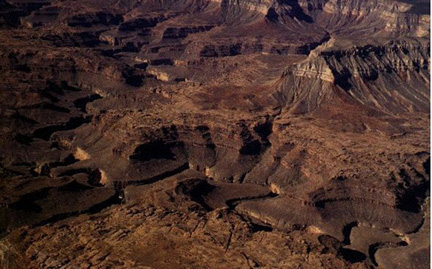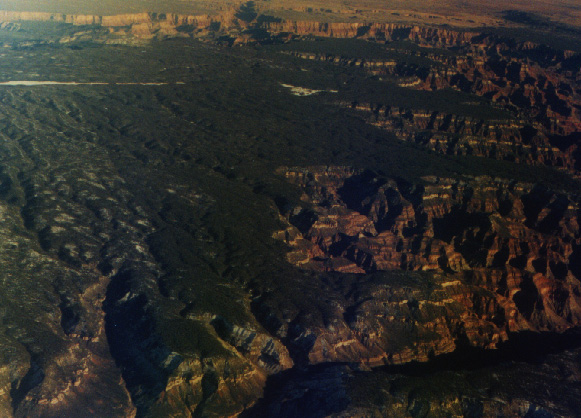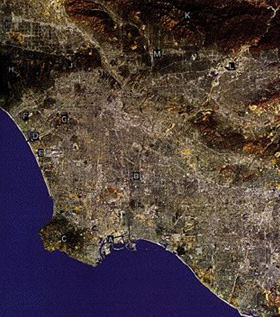 "The
river twisted madly. It swung north, then headed south, then back
north, then east -- east! -- then back south."
"The
river twisted madly. It swung north, then headed south, then back
north, then east -- east! -- then back south." Grand Canyon, of the Colorado River in Arizona.
| Marble Canyon |
 "The
river twisted madly. It swung north, then headed south, then back
north, then east -- east! -- then back south."
"The
river twisted madly. It swung north, then headed south, then back
north, then east -- east! -- then back south."
Reisner, p. 291.
"The battle over the Grand Canyon Dams was the conservation movement's coming of age."
Reisner, p. 285.
"The emergence of higher national priorities, such as energy or water or population growth, could swing the political pendulum back toward river development."
R. Nash, (1982), p. 237.
Grand Canyon National Monument established by Theodore Roosevelt in 1906, thanks to the work of John Muir among many others. Then the National Park was created by Congress on February 26, 1919.
Reisner, p. 291.

Every ecological problem has three parameters, that is to say all environmental problems have three ways to conceptualize the matters to examine, explain, analyze, and interpret:
Physical | Biological | Social
Physical area
 Basin and Range province, southern region.
Basin and Range province, southern region.
The geology creates the sediments and topography of the Great Basin. Minimal water is available for stream flows which are affected by the rain shadow effect of the Sierra, Cascade and Wasatch Mountains that intercept cool moist Pacific Ocean air masses. The mountains cause snow to accumulate on the peaks and extremely dry conditions prevail on the valley floors and hills.
- The geography is dominated by desert, riparian, canyons, oases, side canyons and mesas.
Mountain 'islands' where rain and snowfall create forests or watersheds.
Widespread salt, caustic minerals (soda and borax) & oil, gas or coal deposits exist.- The Four Corners region: Places defined.
Biological communities
Sonoran desert:
Here life zones in the San Francisco mountain peaks are associations of plants and animals stratified according to altitude and were first described in the natural history literature by C. Hart Merriam.
Saguaro cactus, desert (gopher) tortoise,Kangaroo rats, and ironwood trees are just some keystone species in that they provide conditions for many other dependent species to thrive in marginal, stressful, and arid conditions.
Marble Canyon
The upper dam was proposed to flood Marble Canyon
below Glen Canyon Dam on Lake Powell. At
the time of the proposal the boundaries of the National Park proper
began south of Marble Canyon.
"... the canyon rim , five thousand feet above."
John Wesley Powell, August 26, 1869.
in Reisner, Cadillac Desert, p. 30.
For its scenic, archaeological, and importance to native American peoples the opponents of the dam site here in Marble Canyon were able to argue against this canyon being flooded.
Hal Rothman, pp. 76-77.

National priorities have historically influenced the region's land-use for :
1) irrigation water, (John Wesley Powell)
2) timber, mining and grazing leases (Gifford Pinchot)
3) Flood control (William Mulholland)
4) cheap electricity, sanitation and irrigation water (Floyd Dominy) &
5) Comprehensive River basin planning (W. J. McGee)
Colorado River water for the central Arizona project and the power needed by Phoenix, Los Angeles, Salt Lake City, & San Diego.
The western Los Angeles basin is an example of suburban sprawl and industrial development based on the arrival of the Santa Fe railroad in the 1880s, and orchard crops such as citrus and peaches until it was built on discoveries of oil in the 1890s and water projects in the 1900s. Having exhausted the water sources from the eastern Sierra Nevada mountain range and the Owens River Valley in the 1930s the city launched a plan to build an aqueduct to carry Colorado River water to the city and county and surrounding counties between there and San Diego. Today the region of over 20 million people is the largest concentration of aerospace and defense related engineering facilities in the United States.
Contemporary America relies on intensive energy consumption for transportation, electricity, the pumping or water and manufacturing:
Dual demands for energy
Supply side issue:
Base load capacity of the plants is a technical capability of all generators to produce a steady supply of electrical power at all times of the day. Dams generate base load power very inexpensively & can be used for peak load.
Demand side issue:
Peak load is power needed well in excess of the base load requirement when every customer demands electricity at certain times of the day. A graph of the demand would peak at those hours of maximum demand.
electricity is hard to store
Revealing layers: geological or "deep" time the earth as a
locus of numerous previous ecological associations of plants & animals on the same sites. Ancient
sea creatures revealed the origins of the limestone that line
the towering walls of the canyon. Layers of dinosaurs, beneath
layers of flowers are found.
The canyon is deeply moving since its layers of geological
history are like pages in a book which when read carefully unfold
the story of an evolution of life from jelly like medusa and slithering
worms of warm Cambrian seas to petrified conifers of harshly cold
ice ages.
The walls keep the secrets of millions of years of plant and animal evolution.
Early morning along the lower run of Marble Canyon's gorge.
"Nankoweep"
Mesa overlooks the Colorado River composed of a wall
of Permian &Cretaceous eras' rocks.
The green shrubs are an exotic flood intolerant species from the near east called "tamarisk." Originally planted by soil engineers to protect from loss of topsoil these trees crowd out native shrub and tree diversity throughout the river's stream bed. Floods of significant magnitudes no longer occur; tamarisk out thrives competitors such as willow and cottonwood.
Native Land belongs to the Hopi, Navajo and Hualapai Indians
Hopi ceremonial salt springs are examples of both sacred, ceremonial lands & conservation since salt is a preservative and necessary food additive. The concept of geopiety refers to the outward respect shown by people of the Earth's divine, transcendent, or sacred qualities.